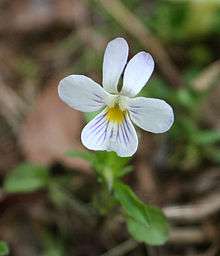Viola bicolor
| Viola bicolor | |
|---|---|
 | |
| A light morph of Viola bicolor growing in a sandy field along the mouth of the James River in southeastern Virginia | |
| Scientific classification | |
| Kingdom: | Plantae |
| (unranked): | Angiosperms |
| (unranked): | Eudicots |
| (unranked): | Rosids |
| Order: | Malpighiales |
| Family: | Violaceae |
| Genus: | Viola |
| Species: | V. bicolor |
| Binomial name | |
| Viola bicolor Pursh | |
| Synonyms | |
| |
Viola bicolor, commonly known as the American field pansy or wild pansy, is an annual plant in the violet family found throughout much of North America. There is some debate as to whether the plant is native to North America or if it was introduced from the Old World as a variety of Viola kitaibeliana, but it is now generally thought to have originated in the New World. It is common in disturbed habitats, but is also found in fields and open woods on substrates ranging from sandy soil to clay to limestone.[2][3][4]
References
- ↑ "Viola bicolor". NatureServe Explorer. NatureServe. Retrieved 2008-03-20.
- ↑ Clausen, Jen; Channell, R.B.; Nur, Uzi (1964), "Viola rafinesquii, the only Melanium violet native to North America", Rhodora, 66 (17)
- ↑ McKinney, Landon E.; Russel, Norman H. (2002), "Violaceae of the Southeastern United States", Castanea, 67 (4): 369–379
- ↑ Hayden, W. John; Clough, John (1990), "Methyl Salicylate Secretory Cells in Roots of Viola arvensis and V. rafinesquii (Violaceae)", Castanea, 55 (1): 65–70
External links
![]() Media related to Viola bicolor at Wikimedia Commons
Media related to Viola bicolor at Wikimedia Commons
This article is issued from Wikipedia - version of the 6/6/2016. The text is available under the Creative Commons Attribution/Share Alike but additional terms may apply for the media files.
